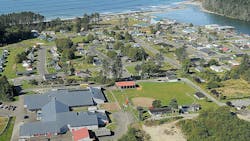Closing the Digital Divide in Indigenous Communities and Beyond
“This is about more than just the internet.” Toptana, the first subsea cable company owned by a sovereign Indian Nation is taking matters into their own hands.
Reliable high-speed connectivity is essential to thriving in the modern economy. But many communities, including many Tribal and other rural communities, don’t have it.
Recent studies have shown1 that less than one-quarter of households in indigenous communities have access to quality, high-speed internet. Thirty-three percent (33%) of reservation residents2 rely on cell phone service for at-home internet.
My community, the Quinault Indian Nation (QIN), is all too familiar with the digital divide. We are a community of over 2,000 people and over 210,000 acres of land, including 27 miles of Pacific coastline. Approximately one-third of our QIN community lacks internet access of any kind, creating challenges in vital areas such as economic development, education, emergency response, and telehealth.
To address this issue, we have taken matters into our own hands. Through the launch of Toptana Technologies—the first subsea cable company owned by a sovereign Indian Nation—we are building an open and neutral cable landing station to provide diverse, transpacific network capacity from the U.S. to the Asia-Pacific market. This will be the first new cable landing station in Washington State since 1999.
Our new fiber optic backhaul network will enable secure and reliable access from the coast of Washington out to the I-5 corridor with onward connectivity to Seattle, Washington, and Hillsboro, Oregon. By developing first-mile (ocean fiber) and middle-mile (regional) connectivity, we are providing the critical infrastructure to make last-mile (fiber-to-the-home) development possible for the benefit of QIN as well as surrounding communities.
Challenges to Developing Infrastructure
The process of obtaining permits to build new cable landing stations and lay submarine cables is often long and complex, with obstacles ranging from regulatory issues to environmental considerations.
Deploying backhaul fiber optic cables is also a challenging process that often requires obtaining permits and permissions from various government agencies, which may have different requirements and processes—creating additional delays and complexity.
Once installed, these cables require ongoing repair and maintenance to ensure optimal performance. Maintenance can be expensive and time-consuming, particularly in remote or hard-to-reach areas.
Toptana’s Approach to These Challenges
Toptana Technologies aims to overcome these challenges.
The sovereignty of the QIN, our abundance of underdeveloped land, and our adjudicated ocean rights 30 miles into the ocean are key reasons we’ve been able to move forward with a cable landing station where others have been stymied since 1999.
With careful consideration of environmental resources and concern for the fishing industry, we determined that QIN territory was a highly feasible landing point and one which uniquely overcame the aforementioned challenges. In 2019, we began to find industry partners that could help us balance technological progress, develop a sustainable economy, provide stewardship of land and waters, and ultimately bring a positive impact for countless generations ahead.
The intent of having as little environmental impact as possible has carried throughout the entire development process. We’ve worked with industry experts to explore the impact of the submarine cable, cable landing station and backhaul network on natural resources in the area, and through extensive studies, we validated the minimal impact of the infrastructure.
Ensuring Connectivity for All
We’re building this digital infrastructure because it’s essential, and we’re uniquely able to solve the challenges that have stymied developers for over 20 years.
But we can’t do it alone. Collaborations between the government and private sector could combine public resources with private expertise to accelerate the development of broadband infrastructure. Streamlining the permitting and approval process could help to reduce costs and accelerate the deployment of new infrastructure, while policies that require broadband providers to allow other service providers to use their infrastructure could help to reduce costs and promote competition.
Historic public funding for broadband internet is now rolling out, but there are barriers that make it particularly difficult for smaller communities and companies to compete for funding. Despite our progress, the fact that we will connect the currently unconnected, and the cooperative nature of the development between QIN and the private sector, Toptana remains fully funded by the QIN.
This is about more than just the internet. It's about the opportunities high-speed internet enables that allow us to be actively involved in modern society—leading to additional preservation of our way of life parallel to increased sharing of our gifts and traditions with the global community.
References
1. Digital Equity for Indigenous Communities, https://www.socialconnectedness.org/digital-equity-for-indigenous-communities/
2. Tribal Technology Assessment, https://aipi.asu.edu/sites/default/files/tta_fact_sheet_compressed.pdf
About the Author
Tyson Johnston
Chairman of the Board and Head of Development, Toptana Technologies
Tyson Johnston is the Chairman of the Board and Head of Development for Toptana Technologies. Follow him on LinkedIn. For more information regarding Toptana, visit https://www.toptanatech.com/. Follow them on Twitter and LinkedIn.
